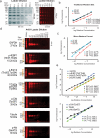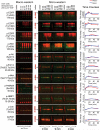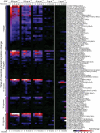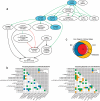Systems analysis of EGF receptor signaling dynamics with microwestern arrays
- PMID: 20101245
- PMCID: PMC2881471
- DOI: 10.1038/nmeth.1418
Systems analysis of EGF receptor signaling dynamics with microwestern arrays
Abstract
We describe microwestern arrays, which enable quantitative, sensitive and high-throughput assessment of protein abundance and modifications after electrophoretic separation of microarrayed cell lysates. This method allowed us to measure 91 phosphosites on 67 proteins at six time points after stimulation with five epidermal growth factor (EGF) concentrations in A431 human carcinoma cells. We inferred the connectivities among 15 phosphorylation sites in 10 receptor tyrosine kinases (RTKs) and two sites from Src kinase using Bayesian network modeling and two mutual information-based methods; the three inference methods yielded substantial agreement on the network topology. These results imply multiple distinct RTK coactivation mechanisms and support the notion that small amounts of experimental data collected from phenotypically diverse network states may enable network inference.
Figures






Similar articles
-
Microwestern Arrays for Systems-Level Analysis of SH2 Domain-Containing Proteins.Methods Mol Biol. 2017;1555:453-473. doi: 10.1007/978-1-4939-6762-9_27. Methods Mol Biol. 2017. PMID: 28092050
-
Microbead arrays for the analysis of ErbB receptor tyrosine kinase activation and dimerization in breast cancer cells.Assay Drug Dev Technol. 2010 Feb;8(1):27-36. doi: 10.1089/adt.2009.0208. Assay Drug Dev Technol. 2010. PMID: 20035613 Free PMC article.
-
SRC-family tyrosine kinases in wound- and ligand-induced epidermal growth factor receptor activation in human corneal epithelial cells.Invest Ophthalmol Vis Sci. 2006 Jul;47(7):2832-9. doi: 10.1167/iovs.05-1361. Invest Ophthalmol Vis Sci. 2006. PMID: 16799022 Free PMC article.
-
The ErbB signaling network in embryogenesis and oncogenesis: signal diversification through combinatorial ligand-receptor interactions.FEBS Lett. 1997 Jun 23;410(1):83-6. doi: 10.1016/s0014-5793(97)00412-2. FEBS Lett. 1997. PMID: 9247128 Review.
-
ErbB Receptors and Cancer.Methods Mol Biol. 2017;1652:3-35. doi: 10.1007/978-1-4939-7219-7_1. Methods Mol Biol. 2017. PMID: 28791631 Review.
Cited by
-
A dual array-based approach to assess the abundance and posttranslational modification state of signaling proteins.Sci Signal. 2012 Jan 10;5(206):pl1. doi: 10.1126/scisignal.2002372. Sci Signal. 2012. PMID: 22234610 Free PMC article.
-
Pathway and network approaches for identification of cancer signature markers from omics data.J Cancer. 2015 Jan 1;6(1):54-65. doi: 10.7150/jca.10631. eCollection 2015. J Cancer. 2015. PMID: 25553089 Free PMC article. Review.
-
Lymphoblastoid cell lines in pharmacogenomics: how applicable are they to clinical outcomes?Pharmacogenomics. 2013 Apr;14(5):447-50. doi: 10.2217/pgs.13.32. Pharmacogenomics. 2013. PMID: 23556440 Free PMC article.
-
A bead-based western for high-throughput cellular signal transduction analyses.Nat Commun. 2016 Sep 23;7:12852. doi: 10.1038/ncomms12852. Nat Commun. 2016. PMID: 27659302 Free PMC article.
-
Domain-based biosensor assay to screen for epidermal growth factor receptor modulators in live cells.Assay Drug Dev Technol. 2012 Feb;10(1):24-36. doi: 10.1089/adt.2011.423. Epub 2012 Jan 26. Assay Drug Dev Technol. 2012. PMID: 22280060 Free PMC article.
References
-
- Burnette W. Western Blotting”: Electrophoretic transfer of proteins from sodium dodecyl sulfate polyacrylamide gels to unmodified nitrocellulose and radiographic detection with antibody and radioiodinated protein A. Analytical Biochemistry. 1981;112:195–203. - PubMed
-
- Paweletz CP, Liotta LA, Petricoin EF. New technologies for biomarker analysis of prostate cancer progression: Laser capture microdissection and tissue proteomics. Urology. 2001;57:160–3. - PubMed
-
- Paweletz CP, et al. Reverse phase protein microarrays which capture disease progression show activation of pro-survival pathways at the cancer invasion front. Oncogene. 2001;20:1981–9. - PubMed
-
- Sachs K, Perez O, Pe'er D, Lauffenburger DA, Nolan GP. Causal Protein-Signaling Networks Derived from Multiparameter Single-Cell Data. Science. 2005;308:523–529. - PubMed
Publication types
MeSH terms
Substances
Grants and funding
LinkOut - more resources
Full Text Sources
Other Literature Sources
Research Materials
Miscellaneous

